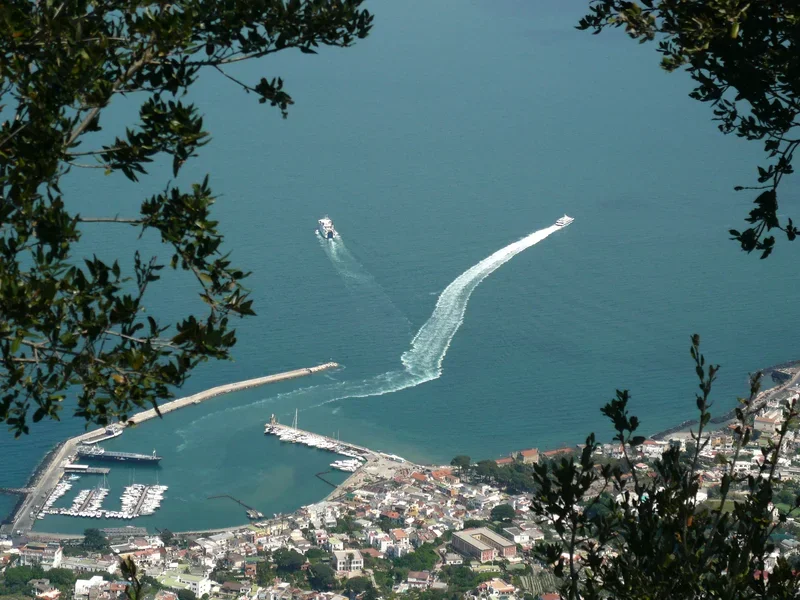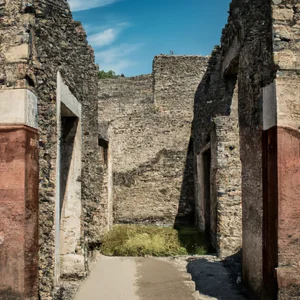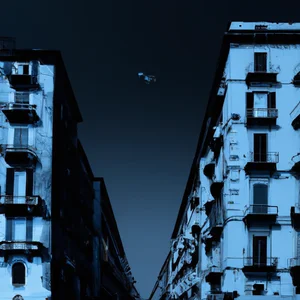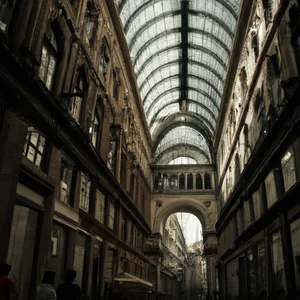Book your experience
Palazzo Zevallos Stigliano
Located in the beating heart of Naples, Palazzo Zevallos Stigliano represents one of the artistic and cultural gems of the city. This magnificent building is not only an extraordinary example of Baroque architecture, but it is also a place steeped in history, which tells of centuries of events and personalities that have contributed to shaping the Neapolitan identity. Its imposing façade is an invitation to discover a world of beauty and culture that lies within. In this article, we will explore ten fundamental aspects of Palazzo Zevallos Stigliano, starting from its fascinating history, which dates back to the 17th century, up to the cultural importance it has today. The architecture and design of the palace, with its elegant decorations and sumptuous interiors, tell us of an era in which Naples was a nerve center of art and culture. We cannot forget the works of art preserved inside the palace, including the famous “Martyrdom of Saint Ursula” by Caravaggio, which attracts visitors from all over the world.Furthermore, Palazzo Zevallos Stigliano is an important center for temporary exhibitions and art collections, further enriching the city’s cultural offering. The guided tours and organized activities allow you to completely immerse yourself in Neapolitan history and culture, making the visit a memorable experience. Finally, we will provide practical information on accessibility, opening times and useful tips to make your visit to the palace an even more pleasant experience. Join us on this journey through the beauty and history of Palazzo Zevallos Stigliano, where every corner tells a story and every work of art is a treasure to be discovered.
History of the Palace
The Palazzo delle Arti di Napoli, also known as PAN, has a rich and fascinating history that dates back to the 17th century. Originally built as a noble palace, the complex has undergone numerous changes over the years, reflecting the different historical eras and the various uses to which it was intended.
In 1866, the palace was acquired by the Municipality of Naples and, after a careful restoration, it was inaugurated as a venue for artistic exhibitions. Its function has been further expanded over time, becoming an important cultural center for contemporary art and the promotion of Neapolitan culture.
Today, the Palazzo delle Arti in Naples is not only a place to admire works of art, but is also a meeting point for artists, curators and art enthusiasts, actively contributing to the cultural life of the city.
Architecture and Design
The Palace, with its imposing structure, represents a perfect example of baroque architecture, characterized by curved lines and elaborate decorations. Built in the 17th century, the Palace stands out for its majestic façade, adorned with wrought iron balconies and windows with sculpted frames.
External
The facade is divided into floors, each of which has a different decorative style. The stone sculptures and stucco ornaments enrich the exterior appearance, while the large entrance doors offer spectacular access to the interiors. The use of local materials, such as tuff and piperno, gives the Palace a distinctive character rooted in the Neapolitan context.
Interior
Inside, the Palace boasts a series of frescoed halls that tell mythological and historical stories, created by renowned artists of the time. The rooms are decorated with period furniture and fine fabrics, which testify to the luxury and refinement of noble life. The internal courtyard, with its central fountain, is a highly evocative place, where you can appreciate the play of light and shadow created by the surrounding architecture.
Style Influences
The design of the Palace reflects the influences of different artistic movements, from the Renaissance to the Baroque, creating an eclectic mix that fascinates visitors. The golden decorations and the Murano glass candelabras testify to the influence of the local artisan tradition and the importance of the Palace as a center of culture and art.
Preserved Works of Art
The Palace of Naples is a true treasure chest of artistic treasures, housing within it numerous works of art of inestimable value. These works not only tell the history of the city, but also represent important artistic expressions of different eras and styles.
Frescoes and Paintings
Inside the Palace, you can admire frescoes dating back to the Baroque period, which decorate the main rooms and corridors. These frescoes, characterized by bright colors and elaborate details, are works by local and national artists, who contributed to creating a unique and evocative atmosphere.
Sculptures
The Palace also houses a significant collection of sculptures, ranging from the classical to the contemporary period. Some of these works were created by internationally renowned sculptors, while others come from emerging artists from the local scene. The sculptures are arranged in such a way as to offer visitors a visual journey that highlights the beauty and variety of artistic forms.
Collections of Sacred Art
A further section of the Palace is dedicated to sacred art, with a selection of works that include paintings, relics and liturgical objects. These works not only have an artistic value, but also a historical and religious importance, testifying to the devotion and faith of the community over the centuries.
Temporary Exhibitions of Contemporary Artists
The Palace is also a dynamic place for contemporary art, hosting temporary exhibitions featuring works by modern and contemporary artists. These exhibitions offer a unique opportunity to explore current trends in the art world and connect with new generations of creatives.
The combination of historical and contemporary works of art makes the Palace an unmissable place for art enthusiasts and anyone who wishes to immerse themselves in the rich culture of Naples.
Caravaggio and the Martyrdom of Saint ‘Orsola
The Martyrdom of Saint Ursula, a work by Michelangelo Merisi da Caravaggio, is one of the most famous creations of the baroque master and represents a culminating point of his artistic career. This painting is characterized by an intense use of light and shadow, a technique known as chiaroscuro, which Caravaggio perfected throughout his life.
Historical Context
Commissioned for the church of San Lorenzo in Lucina in Rome, the Martyrdom of Saint Ursula was created around 1610, shortly before the artist’s death. The canvas represents the dramatic moment in which Saint Ursula, a Christian martyr, is murdered by her tormentors. Caravaggio, known for his ability to capture human emotion, manages to convey the saint’s suffering and sacrifice in an extraordinary way.
Description of the Work
In the work, Saint Ursula is portrayed in a moment of profound suffering, surrounded by figures representing her executioners. The composition is dynamic, with figures moving in a sort of macabre dance. The dramatic use of light highlights the faces and expressions of the characters, creating a strong visual impact.
Importance of the Work
The Martyrdom of Saint Ursula is fundamental not only for its artistic quality, but also for its spiritual message. The representation of the martyr is a reflection on the theme of faith and sacrifice, themes dear to Caravaggio and his time. This work influenced many subsequent artists and remains a masterpiece of art history.
Visibility and Conservation
Currently, the Martyrdom of Saint Ursula is not permanently displayed in a museum, but is the subject of temporary exhibitions and loans to art institutions around the world. Its conservation is delicate, given the nature of the materials used and the exposure to light. Experts work constantly to preserve this work, ensuring that future generations can appreciate its beauty and meaning.
Collections and Temporary Exhibitions
The Palazzo di Napoli hosts a wide range of artistic and historical collections, which reflect the rich cultural heritage of the city and the Campania region. The permanent collections include works by famous artists, contemporary art, and historical pieces that tell the story of Naples through the centuries.
Permanent Collections
The Palace’s permanent collections include:
- Baroque Art: A selection of works representing the Baroque period, with artists such as Caravaggio and Bernini.
- Modern and Contemporary Art: Works by artists of the 20th and 21st centuries, which offer a vision of the continuous evolution of art in relation to Neapolitan culture.
- Archaeological Pieces: A collection of artefacts dating back to Roman and Greek times, highlighting the historical importance of the region.
Temporary Exhibitions
The Palace is also known for its temporary exhibitions, which are organized periodically to present works by contemporary artists, thematic reviews and collaborations with other museums and cultural institutions. These exhibitions offer the opportunity to explore new artistic trends and to engage with works of international relevance.
The temporary exhibitions are an excellent opportunity for visitors to discover lesser-known aspects of Neapolitan artistic culture and to interact with events, workshops and conferences organized in conjunction with the exhibitions.
Events and Activities
Throughout the year, the Palace hosts a series of events, such as conferences, debates and workshops for adults and children, which aim to engage the public and promote a greater understanding of art and culture. These events are often linked to temporary exhibitions, making the experience even more immersive and interactive.
Cultural Importance
The Palace is a fundamental point of reference for Neapolitan and Italian culture in general. Its history and architecture make it a symbol of the city’s rich historical legacy.
Historical Heritage
The Palace has played a crucial role in the historical events of Naples, serving as a venue for important political and cultural events. Its existence testifies to the evolution of the city over the centuries, as well as the influence of different architectural styles and artistic movements.
Cultural Center
Today, the Palace is an active cultural center that hosts events, conferences and artistic displays, thus contributing to the cultural vitality of Naples. The presence of temporary exhibitions and permanent collections enriches the city’s cultural offering and attracts visitors from all over the world.
Acknowledgements and Collaborations
Numerous national and international awards attest to the cultural importance of the Palace. Furthermore, collaborations with prestigious artistic and cultural institutions have allowed it to expand its activities and promote Neapolitan culture on a global scale.
Education and Research
The Palace is also an important center for education and research, offering educational programs and workshops for students and art enthusiasts. These programs aim to raise public awareness of the importance of cultural heritage and stimulate interest in history and art.
Social Impact
The cultural function of the Palace extends beyond its walls, influencing the social fabric of Naples. Through community initiatives, the Palace is committed to involving residents, promoting a culture that is inclusive and accessible to all.
In summary, the Palace is not only a place of architectural and artistic beauty, but is a vital element for the culture and society of Naples, helping to preserve and celebrate the cultural identity of the city.
Guided Tours and Activities
Guided tours of the Palace offer a unique experience to explore the history, art and architecture of the place. Visitors can choose from several tour options, which vary based on duration and thematic focus.
Types of Guided Tours
Visits can be divided into:
- Historical Tour: An in-depth look at the history of the Palace, with details on the noble families who inhabited it and the historical events that characterized it.
- Art Tour: Focused on the works of art featured, including details on the artistic techniques and biography of the artists.
- Thematic Visits: Special occasions that may include themes such as Caravaggio, Baroque architecture or specific cultural events.
Interactive Activities
To make the experience even more engaging, the Palace organizes interactive activities, such as art and history workshops for children and adults, which allow participants to immerse themselves further in the cultural heritage. Furthermore, there are often historical reenactment events that involve the public.
Special Occasions
In certain periods of the year, the Palace hosts special events, such as concerts, conferences and live shows, which further enrich the cultural offering. It is advisable to check the calendar of activities on the official website of the Palace so as not to miss these opportunities.
For a complete and satisfying visit, it is advisable to book in advance, especially during holidays and weekends, when demand is greater.
Accessibility and Opening Times
Accessibility
The Palace is easily accessible to all visitors, including those with reduced mobility. Ramps and elevators are available to ensure easy access to all floors. Furthermore, there are toilets equipped for people with disabilities. It is advisable to contact in advance for specific information on any special needs.
Opening Hours
The Palace is open to the public at the following times:
- Monday - Friday: 9:00 - 19:00
- Saturday: 9:00 - 20:00
- Sundays and holidays: 10:00 - 18:00
It is advisable to check for any time changes during holidays or special events. Furthermore, some areas may be closed to the public during the assembly of temporary exhibitions.
Tickets and Reservations
You can purchase tickets directly at the Palace ticket office or online via the official website. Reservations are recommended, especially for guided tours, to guarantee a place and avoid long waits.
Additional Information
For further details on opening hours, accessibility and reservations, we recommend visiting the official website of the Palace or contacting the information office. Operators are available to answer any questions and provide assistance to visitors.
Location and How to Reach
The Palace is located in a strategic position in the heart of Naples, making it easily accessible to both tourists and residents. It is located in Via del Palazzo, a few steps from some of the city’s main attractions, such as the Naples Cathedral and the National Archaeological Museum.
How to Reach the Palace
The Palace is well connected by public transport. Here are some options to get there:
- Metro: The closest stop is Università (Line 1), just a 10-minute walk from the Palace.
- Bus: Several bus lines stop nearby, including the R2 and 151 lines.
- Taxi: Taxis are easily found throughout the city and can take you directly to the Palace.
Parking
If you are traveling by car, there are parking options nearby, but we recommend checking availability in advance. Paid parking is located near the Palace, but can be expensive and crowded, especially on weekends and holidays.
Additional Information
For a stress-free visit, consider planning your arrival during off-peak hours, and checking for any special events or temporary closures that may affect your visit to the Palace.
Advice for visitors Visitors
Plan your visit
It is advisable to book tickets in advance, especially during high season, to avoid long waits. Always check the official website for any promotions or special events.
Visiting Hours
Check opening hours before visiting, as they may vary depending on the season or special events. Typically, the palace is open every day, but may be closed on certain holidays.
Appropriate clothing
Wear comfortable clothing, as you may have to walk for a long time and visit several rooms. If you are taking a guided tour, a good pair of shoes is essential.
Equipment and Services
The palace offers toilets, a café and a souvenir shop. Remember to check the availability of free wi-fi to share your experiences on social media.
Photography
Taking photos is generally allowed, but check the specific rules for certain works of art or areas of the building. Some spaces may require permission for photography.
Respect for art and culture
Remember to respect the works of art and other visitors. Maintain quiet and respectful behavior to fully enjoy the experience.
Catering Nearby
If you fancy a meal, there are numerous restaurants and trattorias nearby offering local specialities. It is an excellent opportunity to taste Neapolitan cuisine.
Additional Information
Consult the information brochures available at the entrance for further details on the works of art and the history of the building. You can also ask the staff for personalized advice on the routes to follow.































